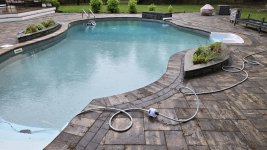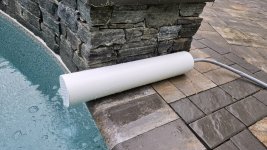- Aug 21, 2020
- 148
- Pool Size
- 19000
- Surface
- Vinyl
- Chlorine
- Salt Water Generator
- SWG Type
- Hayward Aqua Rite (T-9)
I'm trying to find a decently cheap way to remove soluble iron from my pool and from my well water that I use to top off with. After some great advice from @JoyfulNoise in this thread I decided to try a variation of the poly-fill bucket contraption.
I'm going on a theory. A very simple "I may not actually understand this" theory, that's based on the following principles:
Time will tell if this does anything. I'll report back after that first cal-hypo tablet is used up.




I'm going on a theory. A very simple "I may not actually understand this" theory, that's based on the following principles:
- Chlorine reacts with soluble iron and does something indistinguishable from magic that makes the iron get stuck in poly-fill.
- It takes a hot minute for this reaction to occur.
Time will tell if this does anything. I'll report back after that first cal-hypo tablet is used up.








